Circular disk in centre |
Flat circle |
| Slide rules HOME page | INSTRUCTIONS | A-to-Z |
Circular slide rules
Introduction
Although circular slide rules have some advantages over linear slide rules they were never as popular. The two main advantages of this type of slide rule are:
For many users these advantages were offset by the fact that scales near to the centre of a rule had less accuracy than scales near the edge and it is necessary to keep on turning the rule (unless the user gets good at reading scales upside-down and sideways!).
Although many companies made circular rules, and they look different (e.g. flat plastic, pocket-watch types etc.), in fact there are only two types of rule: those with two disks and a single cursor and those with a single disk and two cursors. Among the former are rules by Concise and Fearns; among the latter are rules by Gilson and Fowler. In these instruction I deal with rules of both types pointing out special features of individual models such as the the "binary" scale on the Gilson rules or the spiral scale on the Fowler.
Rules with two disks and one cursor
Makers and construction
This is the commonest type of circular rule. Rules of this type were made by Concise, Aristo and Fearns. With some of them there were two disks, the outer one being rebated to take the inner one. With others there was a flat circle (very much the equivalent of the slide of a linear rule) with static disks outside and inside it. In many cases the disks were protected by a flat sheet of clear plastic; this did have the disadvantage of introducing more possibility of errors in reading the scales due to parallax. Examples of sub-types are given below.
Circular disk in centre |
Flat circle |
The examples for this type of rule are given using a Concise 300B. This rule has the advantage that the scales are labelled as A, B, C etc. and the index (i.e. 1) is clearly marked. The cursor is also labelled with the names of the scales which makes reading scales easier at intermediate points. It is also a duplex rule with a wide range of scales which means that it can used to describe the way to use many other rules.
Front view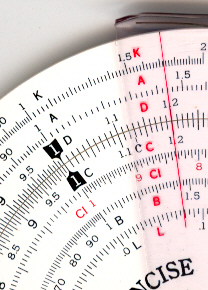 |
Back view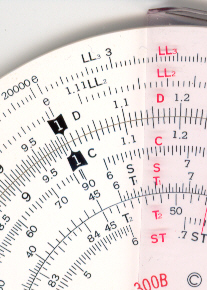 |
C and D scales
As with linear rules, these are the scales most used for basic calculations and the way to multiply and divide on circular rules is very similar to using linear slide rules. We'll start first with simple multiplication and division and then consider calculations with several factors and divisors.
Simple multiplication
Calculation: a * b
1.0 on C to a on D
Cursor to b on C
Answer under cursor on D.
| Example: 8.0 * 1.5 1.0 on C to 8 on D Cursor to 1.5 Answer (12.0) under cursor on D. |
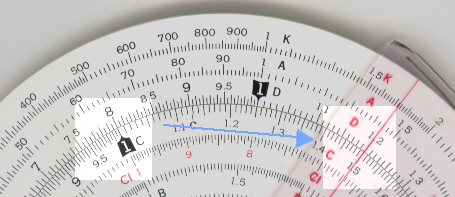 |
Simple division
Calculation: a / b
Cursor to a on D
b on C to cursor
Answer on D against 1 on C
| Example: 1.4 / 7 Cursor to 1.4 on D 7 on C to cursor Answer (0.2) on D against 1 on C. |
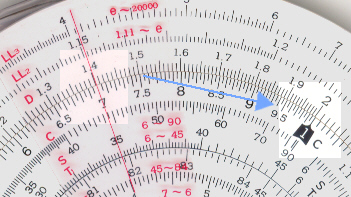 |
Combined multipliation and division
Calculation: a * b / c
Cursor to a on D
c on C to Cursor
Cursor to b on C
Answer on D under cursor.
| Example: 8 * 7.5 / 5 Cursor to 8 on D 5 on C to cursor Cursor to 7.5 on C. Answer (12) on D under cursor. |
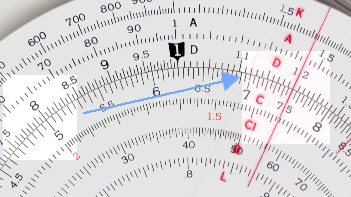 |
If there are further pairs of multiplication and division you can extend the above calculation indefinitely. To extend the above by multiplying by d and dividing by e.
Calculation: a * b * d / ( c * e )
Cursor to a on D
c on C to Cursor
Cursor to b on C
e on C to Cursor
Cursor to d on C
Answer on D under cursor.
| The following example is an extension of the one above. Example:
8 * 7.5 * 4 / ( 5 * 3 ) |
 |
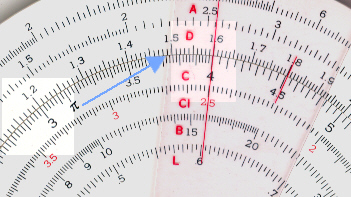 |
The above method works best when the number of numerators is 1 more than the number or
denominators. However it is possible to re-arrange an expression by using extra 1s. For
example:
(a * b * c * d) / (e * f
)
can be re-written as:
(a * b * c * d) / (e * f
* 1 ) .
Similarly:
(a * b ) /( c * d * e * f
) .
can be re-written as:
(a * b * 1 * 1 * 1 ) /( c * d * e
* f ) .
This may appear at first to complicate the calculation but in fact no extra movements are needed.